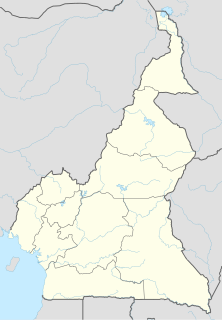Related Research Articles
Mbum proper, or West Mbum, is an Adamawa language of Cameroon spoken by about 51,000 people. Speakers are mostly bilingual in Fulfulde. It is also known as Buna, Mboum, Mboumtiba, and Wuna.

Ngaoundéré, or N'Gaoundéré, is the capital of the Adamawa Region of Cameroon. It had a population of 152,700 at the 2005 census. According to the film Les Mairuuwas – Maitre de l'eau produced by the University of Tromsø, the population has rapidly risen to 1,000,000 owing to mass immigration from the Central African Republic and the perceived danger from Boko Haram in northern Cameroon.
The Mbum–Day languages are a subgroup of the old Adamawa languages family, provisionally now a branch of the Savanna languages. These languages are spoken in southern Chad, northwestern Central African Republic, northern Cameroon, and eastern Nigeria.
The Mbum or Kebi-Benue languages are a group of the Mbum–Day branch of the Adamawa languages, spoken in southern Chad, northwestern Central African Republic, northern Cameroon and eastern Nigeria. Their best-known member is Mbum; other languages in the group include Tupuri and Kare.
Tupuri is a language mostly spoken in the Mayo-Kebbi Est Region of southern Chad and in small parts of northern Cameroon. It is an Mbum language spoken by the Tupuri people with approximately 300,000 speakers.

The Kingdom of Bamum (1394–1884) was a pre-colonial Central African state in what is now northwest Cameroon. It was founded by the Mbum, an ethnic group from northeast Cameroon. Its capital was the ancient walled city of Fumban.
The Kim languages are a small group of the Mbum–Day languages of the provisional Savanna family, spoken in southern Chad. There are there languages:
Mundang is an Mbum language of southern Chad and northern Cameroon.
Kuo (Koh) is an Mbum language of southern Chad and northern Cameroon.
Pana is an Mbum language of the Central African Republic. A few thousand speak it in southern Chad and northern Cameroon. A dialect in Cameroon, Man, may be a separate language. Blench (2004) leaves Pondo and Gonge in CAR unclassified within the Mbum languages.
Kare is a southern Mbum language of the Central African Republic, spoken by the Kare people in the mountains of the northeasterly Ouham-Pendé prefecture around Bocaranga. It is spoken by around 97,000 people in the country, and another few thousand speakers in Cameroon. The language's presence on the southeastern edge of the Mbum family is thought to reflect early 19th-century migrations from the Adamawa Plateau, fleeing Fulani raids.
Sakpu is an Mbum language of southern Chad.
Karang language is an Mbum language of Cameroon and Chad.
Mangbai is an Mbum language of northern Cameroon and southern Chad.
Mono is a moribund Mbum language spoken by older adults in northern Cameroon. A probable dialect, Dama, may already be extinct.
Ndai, also known as Galke or Pormi, is a nearly extinct Mbum language of northern Cameroon.
Pam is a nearly extinct, unclassified Mbum language of northern Cameroon.
To is an unclassified Mbum language of northern Cameroon and the Central African Republic. It is only used as a second language, as the secret male initiation language of the Gbaya.
Kali is a presumably moribund Mbum language of northern Cameroon or the Central African Republic.
La'bi is the esoteric ritual language of male initiation among the Gbaya Kara, the Mbum, and some Sara Laka, in the area of Touboro near where the CAR, Chad, and Cameroon meet. It has no native speakers. It is related to Mbum, with substantial loans from one or more Sara languages.
References
- ↑ Nzakambay at Ethnologue (18th ed., 2015)
- ↑ Hammarström, Harald; Forkel, Robert; Haspelmath, Martin, eds. (2017). "Nzakambay". Glottolog 3.0 . Jena, Germany: Max Planck Institute for the Science of Human History.
| This article about Atlantic–Congo languages is a stub. You can help Wikipedia by expanding it. |
| This article about a language spoken in Cameroon is a stub. You can help Wikipedia by expanding it. |
| This Chad-related article is a stub. You can help Wikipedia by expanding it. |